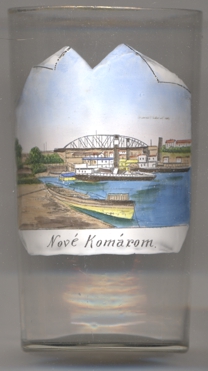

|
| MAGYARORSZÁG | HUNGARY |
| megye: Komárom-Esztergom |
 Komárom is situated at an elevation of 116 m on the right bank of the river Danube, directly opposite the Slovak town of
Komárno with which it shares most of its history. The municipality has a population of about 18,800 (2017).
Komárom is situated at an elevation of 116 m on the right bank of the river Danube, directly opposite the Slovak town of
Komárno with which it shares most of its history. The municipality has a population of about 18,800 (2017).
In Roman times the legionary camp Brigetio with an important civilian town was located here. However, nothing of it remains visible totay. At the beginning of the 12th century, a Benedictine monastery was founded here, mentioned in 1222 by the name monastorium de Koppán. The Turks destroyed much of the monastery and its surroundings in 1529, and the area was thus depopulated. The town was heavily damaged in the 1763 Komárom earthquake. Between 1850 and 1871 the Fort Monostor (Monostori Erőd) was built nearby. Originally, the name of the town at this site was Új-Szőny, but in 1896 it was merged with the town north of the Danube, which at the time was already known as Komárom in Hungarian (Komárno in Slovak, Komorn in German) as both were part of the Kingdom of Hungary (part of the Austrian-Hungarian Monarchy). After World War I, the northern part of the town was occupied by Czechoslovak troops in 1919. The division was finally recognised by the Treaties of Paris (Treaty of Trianon) in 1920. The Slovak part of the town today is Komárno. After World War II the occupying Soviets built the country's biggest ammunition storage in the Fortress of Monostor. Thousands of wagons of ammunition were forwarded from this strictly guarded area. One of a series of forts, the Monostor is today open to the public as a museum.
The  Elisabeth Bridge (Erzsébet-híd in Hungarian, Alžbetín most in Slovak) was built
in 1891–1892 and was the first fixed bridge across the Danube in Hungary outside of Budapest. In 1914 the wooden roadway
was replaced with prefabricated reinforced concrete slabs, which were replaced by a monolithic reinforced concrete slab in 1927. The bridge was blown up
during World War II but rebuilt immediately after the war in 1946. Renovations took place in 1962 and 1980. Extensive renovations were carried out
in 2004&ndsh;2006.
Elisabeth Bridge (Erzsébet-híd in Hungarian, Alžbetín most in Slovak) was built
in 1891–1892 and was the first fixed bridge across the Danube in Hungary outside of Budapest. In 1914 the wooden roadway
was replaced with prefabricated reinforced concrete slabs, which were replaced by a monolithic reinforced concrete slab in 1927. The bridge was blown up
during World War II but rebuilt immediately after the war in 1946. Renovations took place in 1962 and 1980. Extensive renovations were carried out
in 2004&ndsh;2006.
[https://de.wikipedia.org/wiki/Kom%C3%A1rom;, https://en.wikipedia.org/wiki/Kom%C3%A1rom;
https://en.wikipedia.org/wiki/1763_Kom%C3%A1rom_earthquake;
https://de.wikipedia.org/wiki/Elisabethbr%C3%BCcke_(Kom%C3%A1rom);
http://fallingrain.com/world/HU/12/Komarom.html]
![[scale]](lineal.jpg)